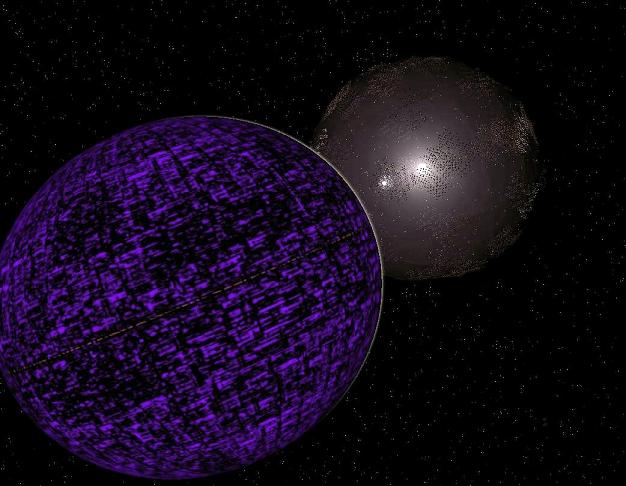BY LETTER
Ain Soph Aur (Delta Capricorni)
Galactography > Sephirotic Empires > Keter Dominion
Galactography > Systems and Worlds > Systems & Worlds A - B
Galactography > Systems and Worlds > Systems & Worlds A - B
Capital system of the Keter Dominion | |
 Image from Steve Bowers | |
| Node Euclid, one of the one thousand Jupiter-class processor nodes which surrounds the star Deneb Algiedi. Around the star can be seen the primary swarm of power collection nodes | |
Galactography | |
| System: | Ain Soph Aur |
|---|---|
| Primary: | Deneb Algedi (Delta Capricorni Aa) - Distance from Sol: 39ly |
| Stellar Type: | A5 (modified to A8); a companion star orbits close to the primary |
| Region: | Inner Sphere Imperial Capital (Keter Dominion) |
| Planets: | No natural planets remain in the Delta Capricorni system. Rather all available planetary mass, as well as some 240 Jovian masses of material removed from the two stars, has been converted into power collection systems, computronium, and habitats. Additional construction material has also been imported from other star systems. |
| Important Local Artificial Intelligence: | AI overseer: Keter AI's ethos: Supports lesser beings who attempt to refine themselves and reach perfection, although it is also one of the most aloof archailect clusters - it is up to everything to strive, but the only thing Keter provides is the light to aim at. (see also - Keterism) |
| Infrastructure and Major Industries: | Exports - commodities: exotic matter, iso parts, computronium, godtech devices, transapient expert systems, high toposophic simulations, magmatter products (various), godseeds. Imports: - commodities: personality constructs, crude organobiota, cultural databases, personality copies, amat. Angelnetting: Angelnetting within the Ain Soph Aur system is virtually total in all areas. Major Orbitals: Orbiting around and between the various Jupiter- nodes that form the core of the Ain Soph Aur system are a huge number of smaller habitats, orwood forests, and computronium nodes. Some 10 million habitat structures, arranged into 1000 orbital bands enclose the Delta Capricorni star. Beneath the innermost layer of habitats and computronium nodes, a power collection swarm intercepts some 95% of available solar energy. Only 5% of the radiant energy of the star is allowed to shine into space to illuminate those habitats and environments that have the most need of solar input. These are typically placed in equatorial orbits around the star, while environments that are better suited to sunless conditions are mainly clustered into orbits that are primarily shaded by the collector array. |
| Population: | Some 28 trillion corporeal entities and several orders of magnitude more software-based beings inhabit the Ain Soph Aur system at any given time. The system population covers a huge range of races and clades from near-baselines to vecs, to provolves, to neogens and practically everything in between. The sheer size of Terragen Civilization precludes representatives from all the known races being present in the Ain Soph Aur swarm, but to the casual observer it can often seem like they are trying. |
| Travel: | Stargates: Transfinity to Aksijaha Bright Door to Barboro Eschaton to Branswerg Spaceports: None specific. Transportation within the Ain Soph Aur system is provided by one of the most sophisticated systems in the known galaxy. Halo technology, similar to that employed by the Black Angel ISO system, lifts and moves transport pods at high speed, while protecting their passengers from the associated acceleration forces. Using this system, it is possible to reach any point in the Ain Soph Aur system within a standard day. This same system provides transport to and from the local wormhole gates and controls the path of any interstellar vessels that may enter the system via normal space. Hazard Rating: 0.0 Ain Soph Aur is the symbolic center of the Keter overmind and completely safe for any sophonts in the system. It should be noted, however, that Ain Soph Aur represents only a fraction of the total computronium mass of the entire entity known as Keter and that other processor nodes may not be as optimized for habitation by guest beings. Visa Restrictions: Access to the Ain Soph Aur system is heavily regulated. Entrance visas must be granted by the priesthood caste. Exact reasons for either the granting or denial of a visa are often not forthcoming. On occasion access is granted by invitation rather then request, again for reasons that may not be readily apparent to the sophont so recognized. |
The Ain Soph Aur Dyson Swarm
The Ain Soph Aur system is one of the most heavily developed and advanced in the Inner Sphere, or indeed in the Civilized Galaxy. Originally a hot A5 star massing twice as much as Sol with a much smaller, close companion, both stars have been partially dismantled; both to provide building materials and to extend the lifetime of the primary by some 480 million years. Using the materials harvested from the Delta Capricorni system itself as well as massive quantities of matter imported from other star systems over several millennia, a complex of some 1000 Jupiter class processor nodes now surround the star in a variety of orbits and orbital inclinations. Orbiting each of these processor nodes in turn are six lunar class processor nodes.Each lunar node provides processor support for a huge population of ai, virtual, and a-life entities, existing in a nearly endless variety of virtual habitats, environments, and computational modes. The outer surfaces of each moon node have been made habitable for a variety of races and clades, ranging from high temperature vacuum and Venusian environments close to the primary, to oxygen-water bluesky habitats in the temperate zone, to Mars-type, Europan, and cryogenic, deep vacuum environments as one moves farther from the central stars.
Related Articles
Appears in Topics
Development Notes
Text by Todd Drashner
Initially published on 22 January 2002.
Initially published on 22 January 2002.






